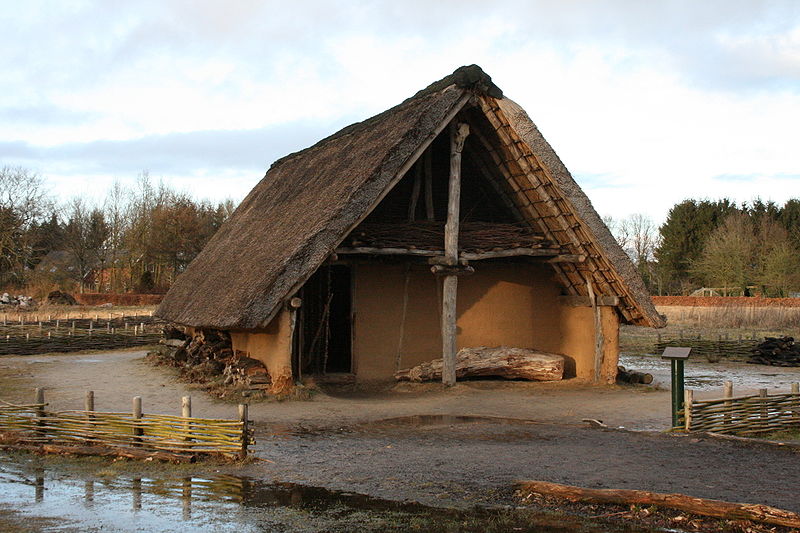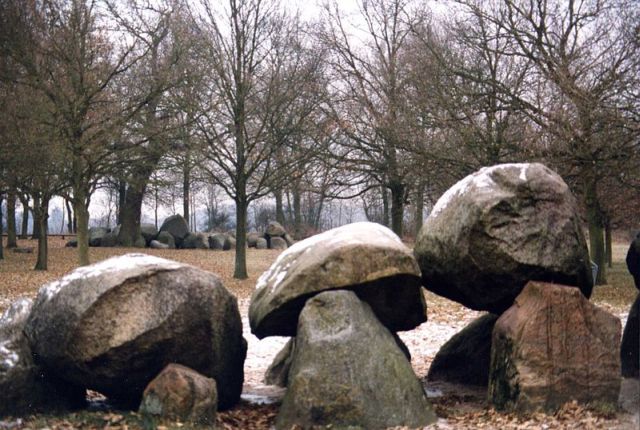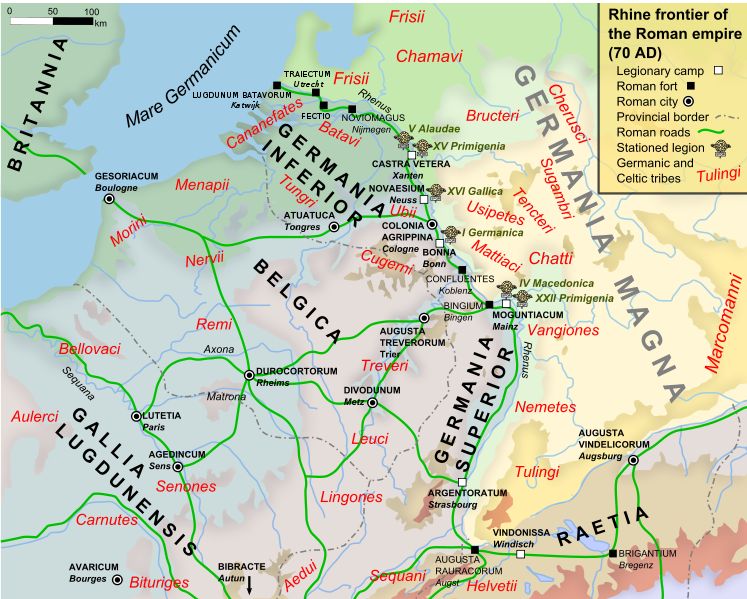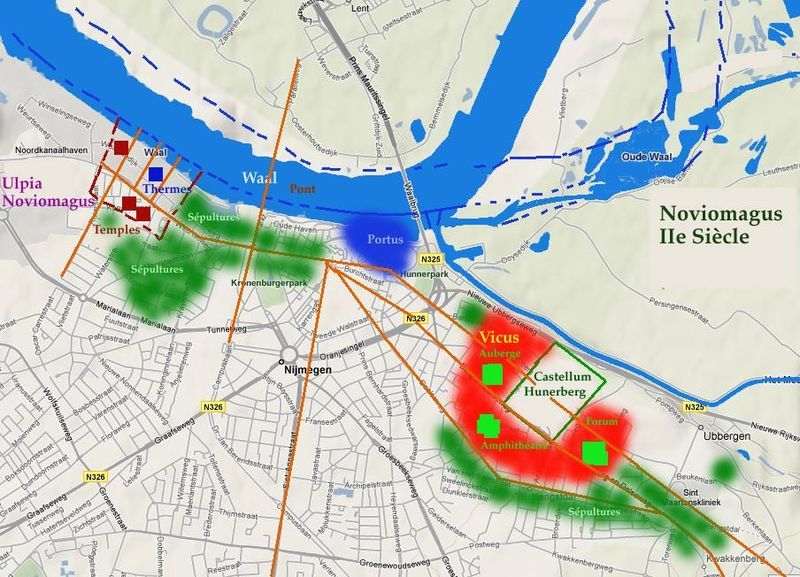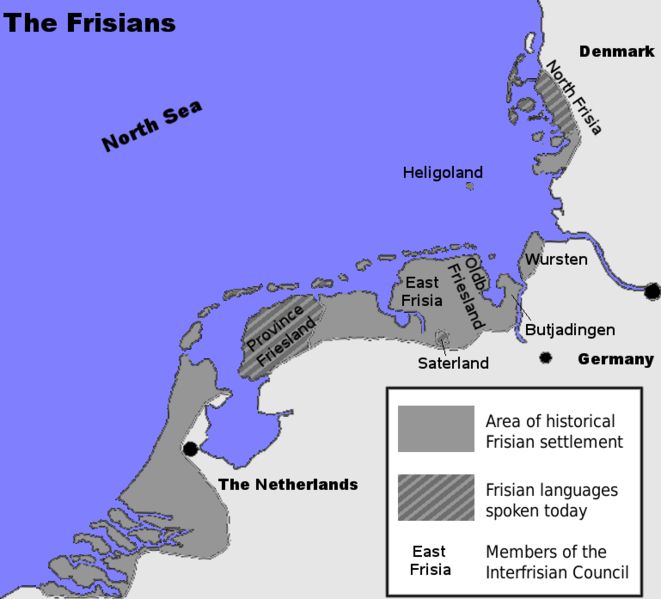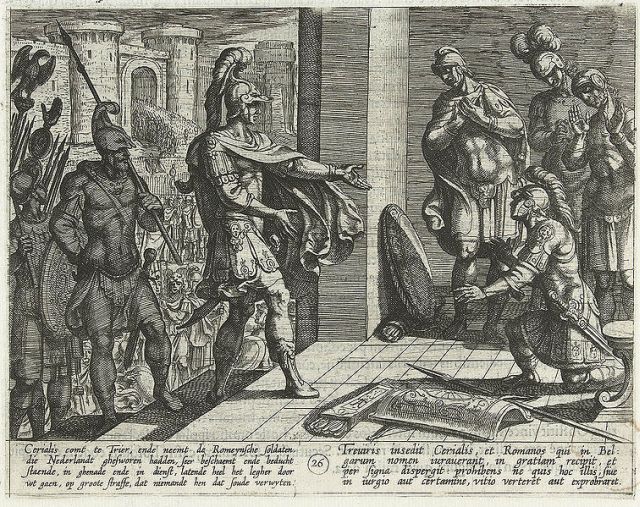1. Pre-history
Traces of human presence in the areas of present-day Netherlands go back hundreds of thousands years ago – the first stone tools used by people in the period of 200.000 – 180.000 BC were found on and near the Veluwe (a part of Gelderland). During the Paleolithic era this part of the country was inhabited by numerous clusters of Neanderthals. One of the proofs is a piece of a skull of a young Neanderthal man, which was found in 2001 in the province of Zeeland, on the coast of the North Sea. The Dutch named him Krijn. Still 4% of their genes come from “him”. This is the first human fossil in the world that comes out of the sea. The age of the skull is estimated at 40,000 – 100,000 years. This valuable finding confirms the presence of the Neanderthals in the Netherlands, as argued before by many remains of their bones and stone tools. One should know that during the Ice Age the North Sea level was much lower than today, uncovering a large part of the North European Plain, the so called “mammoth steppe”, intersected by large rivers, where Neanderthal and later the modern humans (Homo sapiens) lived, fishing, hunting bisons, reindeers and mammoths.
The next stage of settlement in the present Netherlands is associated with the influx of people living from the Black Sea area, known as the Yamna culture (3,400 – 2,700 BC), in the Neolithic period.
Reconstruction of a neolith house, museum Hunebedcentrum in Borger
After the Ice Age the flowing water from melting glaciers and polar caps had risen the global sea levels so salty water from the Atlantic, by Mediterranean Sea fled into the Black Sea what led to soil degradation and in result forcing local populations to look for new places to live. Some of them settled down in what is now the Netherlands. Material remnants of these cultures are not only distinctive clay pots, but also typical stone tombs, the so-called dolmens, consisting of vertically dug into the earth boulders and the great flat rock block.
Dolmens in Rolde
The largest concentration of those megalithic structures, called in Dutch “hunebed”, is located in the province of Drenthe.
2. Germanic invasion
Ca. 1000 BC a lot of the Germanic tribes arrived and settled down in the present Netherlands, which had also Celts in the south of the country. The main reason of this invasion was overpopulation at their homeland so large groups of Germanic peoples were forced to look for a new environment. The term “Germanic” concerns several tribes. In the beginning of this era in the Netherlands lived Batavians, Canninifates, Chamaven, Frisians, Menapii and Tubantes. (To show the complexity: the Menapii were Celts; the Caninefates mixed with Frisians and Batavians, so in later years they became Frisavones, then turned into Rijnlanders, after that they became Hollanders). These tribes were all independent, but they spoke a west Germanic language and shared the same culture. Hence they were called together (west) Germans.
Germans, year 70
The Netherlands looked very different from today. The largest area was marshland. Germanic villages were not much more than a few farmsteads. Its inhabitants cultivated the land and lived on the products of it. As agricultural conditions (water and soil) were different, each tribe lived in a slightly different way. What was common for them, besides the language and culture, was the structure of their society. Every tribe formed its own society, which consisted of several families. The heads of those families were the “rulers”. The top of the social hierarchy were the freemen, which can be compared with nobles. The lower rank was made by the half-freemen, which had to serve to the families, but were fairly free. The lowest in rank were the “servants”, often derived from prisoners of war, which had, of course, nothing to say.
Among the Germanic tribes who settled down in the areas of contemporary Netherlands, an important role in the history of this country was played by the Batavians. It were their actions which are contractually linked to the birth of the Dutch nation (what happened in 69, one hundred years after they inhabited the lands in the present-day Netherlands). This extremely warlike people came from the Chatti tribe, which inhabited the areas of Hesse (Germany). In the middle of the 1st century BC internal tribe conflicts forced Batavians to look for a new place of residence. Probably in the years 50-12 BC they settled down at the mouth of the Rhine, especially on the so-called Batavian Island between the rivers Oude Rijn and the Waal / Maas. Batavian traces have survived until today in the name of the land Betuwe, located between the rivers Waal and the Lek.
Noviomagus, 2nd century
Their capital was the city of Noviomagus, now called Nijmegen; the population was probably 40.000 people. The Batavians were known as adventurous people. According to the Roman historian Tacitus, they could swim so well, that without losing their horses and weapons they could cross the Rhine River in closed units. For this reason they became valuable allies for Romans, who had entered the history of the Netherlands in almost the same time.
According to a lovely legend one Batavian warrior went to the sea which fascinated him as much as a beautiful Frisian girl he met on the beach and married. The old gods liked the story much, so they made the Hollanders a happy people and put a sign on them. So their children are born very blonde (Frisian) but on coming of age they turn darker blonde (Batavian).
The Frisians
Another significant tribe were the Frisians. The (Germanic) Frisians settled in what is now the Netherlands in the 2nd century BC, inhabiting a vast coastline from the Zwin, a bay on the present border of the Netherlands (Zeeland), Belgium (Vlaanderen) and Denmark (southern Jutland). Historical sources do not say much about them (the last reference dates back to 296 onwards), but it is known that in the year 29 they upraised against the Romans (exploiting them: the skins they demanded as tax were larger than the smaller Friesian cows had). The Romans, however didn’t revenge on them. In the 3rd century they experienced strong deterioration of living conditions, caused by rising sea levels and flooding of their lands. This led to a drastic reduction in population and then scattering or absorption by other tribes (most Frisians left their country for England or mixed with Batavians and Caninefates). In the 5th century the old Frisians vanished forever from the pages of History, leaving behind only the name of the region. Abandoned lands were occupied later by the Saxons, from which the present inhabitants of Friesland derive. What is interesting – it was possible to reconstruct the old language. Relying on old writings and some leftovers in dialects the Frisian writer and poet Gysbert Japicx (1603-1666) reconstructed the (new) Frisian language (1650-1950). So there is old Frisian and new Frisian but no middle Frisian (1150-1650)! Present Frisian (after 1950) is called modern Frisian and is defined by the Frisian Academy. The ancient capital was Utrecht, today Leeuwarden is the capital of the Frisian province.
3 The Roman period (57 BC – 420 AD)
3.1 Roman Empire Conquer
Around the 1st century BC lands of the present Netherlands were invaded by Romans, not however without the resistanc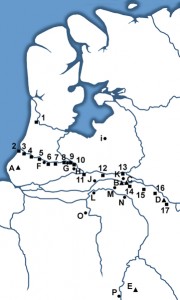 e of Germanic tribes. In 51 BC Julius Caesar incorporated a part of the area to The Roman Empire. After a few attempts that failed, the Invaders didn’t cross the river Rhine to the north; they stayed south of the river and built their strongholds along her shores. A number of towns and other developments arose along this line. Many cities of the present Netherlands originate in the Roman period, like Utrecht (Roman: Ultra Trajectum), Nijmegen (Ulpia Noviomagus) or Leiden (Lugdunum Batavorum). In Octavian Augustus’ time (30 BC – 14 AD) the conquered area was subjected to two “Roman” provinces: the Belgian Gaul and the Lower Germania. The area to the north of the Rhine, inhabited by the Frisians and the Chauci, remained outside Roman rule but not without the emperor control. The Romans tried several times to concur it but were not successful, so they gave in. The approximately 450 years of the Roman rule that followed has profoundly changed the Netherlands. Map: Roman Empire limes.
e of Germanic tribes. In 51 BC Julius Caesar incorporated a part of the area to The Roman Empire. After a few attempts that failed, the Invaders didn’t cross the river Rhine to the north; they stayed south of the river and built their strongholds along her shores. A number of towns and other developments arose along this line. Many cities of the present Netherlands originate in the Roman period, like Utrecht (Roman: Ultra Trajectum), Nijmegen (Ulpia Noviomagus) or Leiden (Lugdunum Batavorum). In Octavian Augustus’ time (30 BC – 14 AD) the conquered area was subjected to two “Roman” provinces: the Belgian Gaul and the Lower Germania. The area to the north of the Rhine, inhabited by the Frisians and the Chauci, remained outside Roman rule but not without the emperor control. The Romans tried several times to concur it but were not successful, so they gave in. The approximately 450 years of the Roman rule that followed has profoundly changed the Netherlands. Map: Roman Empire limes.
When Romans noticed that Germans were too strong to defeat them, they turned some tribes into their allies. This worked so well that many Germanic warriors served Romans emperors. This relates especially to the Batavians, who even served as the emperors guard. As Roman allies for a long time they enjoyed a special treatment. For example: they did not pay any taxes and many of them acquired Roman citizenship. Those proud people never forgot however who they were so after leaving Roman legions and returning home, they became Batavians again and spoke or wrote no Latin anymore.
3.2 The Batavian Rebellion (69/70)
German and Roman relations were not without conflicts however, as evidenced by the anti-Roman Frisian uprising in the year 29 (see Flevoland), supported by Batavians. For the latter, a more serious conflict with the Romans came only in 69. Tension had already been growing as a result of limiting the independence of the Batavians. The spark that led to the outbreak of the war originated in a conflict between two emperors – Vespasian and Vitellius. The latter, in order to win the soldiers, violated the agreements with Batavians (including the illegal draft of young men into his army, he not only took soldiers but also women and boys to please the decadent Romans in Rome. A Batavian man accepting that would lose his honour. (To Batavian law and tradition women were different but equal to men. That equality was ended by the Christian tradition that came much later). For the Batavian chief, Gaius Iulius Civilis, it was a perfect reason for stirring up rebellion. In that upraise Civilis united other tribes in the Netherlands and all tribe chiefs took an oath of brothership, what for many Dutchmen today symbolizes the beginning of the Dutch nation.
Cerialis grants mercy to soldiers that went over to the enemy 69/70 (“revolt of the Batavi” series); Antonio Tempesta
Remarkable is that they started the upraise knowing they could not win. And so it happened although not without some positives. Romans treated their opponents quite kindly, and the Batavian capital Opidum Batavorum was upgraded to the garrison city Ulpa Noviomagus (present Nijmegen), so the Batavians spoke of a “victorieus defeat.” They later merged with other tribes and became part of the Salian Franks but never were forgotten. With the appearance of the first printed works of Tacitus in the 16th century the Dutch interest in the Batavians grew. They became a symbol of “simple, brave people who resisted a cruel oppressor and regained their freedom”. This symbol functioned well in many historical moments, particularly in the Eighty Years War (1568 – 1648) and even during II World War. Many Dutch artists painted images about the Batavians; one of the most famous was “The Conspiracy of Claudius Civilis” by Rembrandt.
Conspiracy of Claudius Civilis, Rembrandt van Rijn, 1662
It was actually Julius Civilis but the Batavian leader is presented in art with the other name.)
3.3 Franks
During the late Roman Empire, at the end of the 3rd century, in the lands of the Netherlands the names of tribes (except de the northern Frisians) vanished. The Franks were the new people although not a new tribe but a mixture of the old tribes. They were free from the duties of their tribe. Frank means free, so they choose were and to whom they wante d to serve. Except the northern Frisians, all tribes joined, sooner or later, the Franks. These Franks split in two groups: the Salians (from Latin for salty) in the west (seaside) they expanded southward and the Ripuardians (from the word for riverbank) in the east. The Salian Franks with the approval of the Roman emperor Constantinus in 297 settled down in the Rhine Delta, among Batavians (it was the last time that this tribe appeared on the History charts), and became dominant there. The “cheeky” establishment of these Salians on Roman territory in the southern Dutch Toxandrië led to the war with Romans, who under the command of the future Roman emperor Julian the Apostate forced them to surrender in 358. It didn’t make Salians weak, they had just started their great career. From about 420 under the leadership of a certain Chlodio the Frankish possessions extended to the river Somme. From about 420 on, under the leadership of Clovis, they began expanding in the direction of the river Somme. Thus a new chapter of their history begun. In the picture, Clovis, “Nuremberg Chronicle”.
d to serve. Except the northern Frisians, all tribes joined, sooner or later, the Franks. These Franks split in two groups: the Salians (from Latin for salty) in the west (seaside) they expanded southward and the Ripuardians (from the word for riverbank) in the east. The Salian Franks with the approval of the Roman emperor Constantinus in 297 settled down in the Rhine Delta, among Batavians (it was the last time that this tribe appeared on the History charts), and became dominant there. The “cheeky” establishment of these Salians on Roman territory in the southern Dutch Toxandrië led to the war with Romans, who under the command of the future Roman emperor Julian the Apostate forced them to surrender in 358. It didn’t make Salians weak, they had just started their great career. From about 420 under the leadership of a certain Chlodio the Frankish possessions extended to the river Somme. From about 420 on, under the leadership of Clovis, they began expanding in the direction of the river Somme. Thus a new chapter of their history begun. In the picture, Clovis, “Nuremberg Chronicle”.
Interesting note:
Ripuardian Franks’ language was significantly influenced by Celtic people who lived in Bavaria and Switzerland. Thus two languages were formed: “Low” German (also called Saxon) in the north and “High” German in the south. The separation line (the Bernrather Line) runs approximately from Danzig on the Baltic coast, south under Berlin and along the southern border of the Dutch province of Limburg. This can be heard in the current local dialects. As Martin Luther translated the Bible into “High” German it became the standard language, and culture, in Germany of today.

